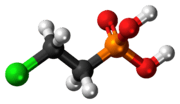Ethephon
 | |
 | |
| Names | |
|---|---|
| IUPAC name
2-Chloroethylphosphonic acid | |
| Other names
Bromeflor Arvest Ethrel | |
| Identifiers | |
| 16672-87-0 | |
| 3D model (Jmol) | Interactive image |
| ChEBI | CHEBI:52741 |
| ChemSpider | 26031 |
| ECHA InfoCard | 100.037.002 |
| KEGG | C18399 |
| PubChem | 27982 |
| UNII | XU5R5VQ87S |
| |
| |
| Properties | |
| C2H6ClO3P | |
| Molar mass | 144.5 g/mol |
| Density | 1.409 g/cm3 |
| Melting point | 74 °C (165 °F; 347 K) |
| 123.9 g/100 ml at 23 C | |
| Hazards | |
| Main hazards | Corrosive |
| Except where otherwise noted, data are given for materials in their standard state (at 25 °C [77 °F], 100 kPa). | |
| | |
| Infobox references | |
Ethephon is the most widely used plant growth regulator.
History
It is manufactured by Rhône-Poulenc (Bayer Crop Science) and Jiangsu Anpon Electrochemicals Co. in China.
Action
Upon metabolism by the plant, it is converted into ethylene, a potent regulator of plant growth and ripeness.
Uses in various crops
It is often used on wheat, coffee, tobacco, cotton, and rice in order to help the plant's fruit reach ripeness more quickly.
Cotton is the most important single crop use for ethephon. It initiates fruiting over a period of several weeks, promotes early concentrated boll opening, and enhances defoliation to facilitate and improve efficiency of scheduled harvesting. Harvested cotton quality is improved.
Ethephon also is widely used by pineapple growers to initiate reproductive development (force) of pineapple. Ethephon is also sprayed on mature-green pineapple fruits to degreen them to meet produce marketing requirements. There can be some detrimental effect on fruit quality.
Although many environmental groups worry about toxicity resulting from use of growth hormones and fertilizers, the toxicity of ethephon is actually very low,[1] and any ethephon used on the plant is converted very quickly to ethylene.[2]
References
- ↑ Pesticide Information Profiles: Ethephon, Extension Toxicology Net. Sept 1995.
- ↑ "1994 Joint meeting of the FAO panel of experts on pesticide residues in food and the environment." UN Food and Agriculture Organization. 1994.